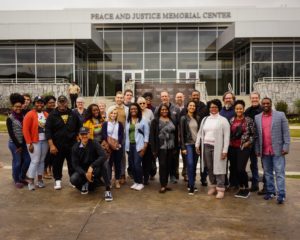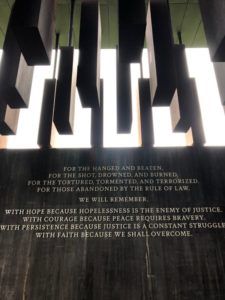Walking onto the University campus I listened to birds deep in song as the morning emerged from dark night; the sky not quite light and not quite dark. Rounding the corner to the building where my office is located stands one bright tree – a tulip tree full of blossom – thriving amongst other trees still stripped bare by the hold of winter.
Beauty can be hard to find some days. Surrounded by brutality, overwhelmed by violence and memories of violence, deafened by the noise of divisive, polarizing and hateful speech, beauty sometimes pops up as a dandelion in the crack of a sidewalk. Perhaps it was a bit poetic that when I boarded a bus an hour later the birds were silenced as rain began to fall from a heavy, gray sky.

On this bus I joined a group of diverse students, faculty and staff from Mercer University McAfee School of Theology and visited the National Memorial for Peace and Justice in Montgomery, Alabama. On its website the Memorial is described as “the nation’s first memorial dedicated to the legacy of enslaved black people, people terrorized by lynching, African Americans humiliated by racial segregation and Jim Crow…” We quietly walked on the grounds of the memorial surrounded by the names of those who, in the name of hate, were shot, burned, or hanged because of the color of the skin.
To date, I have lived or worked in 10 counties, mostly in Georgia. In every one of these counties, with one exception, there were reminders of human beings lynched. Some were whole families and others were listed as “unknown.” This memorial was a somber reminder of a sad and brutal history. I would rather not think about it…but that is part of the problem. The memorial was there to confront me with truths that are too important to forget.
It was a place to confront the truth of racial terror, and truth is both discomforting and liberating.
It was a place of prayer. One professor said that he found himself whispering the “breath prayer” over and over: Lord have mercy. Christ have mercy.
It was a place for lamentation. The incarnated grief over what was and what is was palpable among our group. Questions came at a near stifling pace: “How could they…why…where am I in this…surely not I?”
There was sacredness in all of this. In scripture God is imaged as the One who participates in the suffering of others. Jesus, we know from reading the Gospels, sides with the oppressed and the marginalized, reminding us that when we encounter the sick, the imprisoned, the stranger, the hungry and thirsty we encounter Christ.
Towards the end of our visit I spoke with a couple of docents and asked them, “Surrounded daily by the reminders of a painful history, what gives you hope?” One spoke up and said simply, “The willingness for people to have conversations, even when the conversations are painful. And so I have hope every day because this memorial leads many people to talk.”
Too often I find myself ashamed, fearful, or just plain ignorant and choose either silence or shallow words instead of meaningful exchange. I suspect I am not alone. Too tired. Too lonely. Too overwhelmed. Too hurt. Too much. But while there is a time to keep silence – and at this place I spoke very few words – it is always timely to engage others with compassion.
Jesus spoke to Roman soldiers and the criminally accused; to the broken and beaten and to the ones who thought they had it all together; to the racially and religiously different and to the earnest Pharisee. Jesus spoke with words and with presence. Jesus spoke with tears and, while the Bible does not mention it, I believe with laughter.
Maybe our collective hope is to have important conversations and listen to one another, even when it is painful (maybe especially when it is painful). After all this is what compassion is all about – to share in the pathos of another.
When we boarded the bus to leave Montgomery and head back to Atlanta the late afternoon sun was peaking behind the clouds that had kept it hidden all day, offering a gentle benediction for our departing. There is hope, if we are willing to believe that there is something beyond the clouds.
Gratefully,
Greg



Greg – thank you for this! May I put a link to this on my Facebook page, please?
A beautiful truth and lamentation.
Of course!
Greg,
I am so thankful that our paths crossed and for how you ministered to our hearts and souls during the time when you served as our preacher. I always enjoy reading your articles! It does become increasingly difficult to see the beauty God intended for us to see. We must continue to look down and see ourselves as we are and then look up and praise God for who He is. Our hope lies in Him alone!
Keep up the good work, helping us to see beauty and have hope.
Susan Kious
Thank you!
Hi Greg, thank you for this. It reminds me of Archbishop Desmond Tutu’s Truth and Reconciliation Commission in South Africa, and his book, The Book of Forgiving. These are very hard but necessary truths to confront for any person or nation to heal. Take care and keep in touch.
I enjoyed that